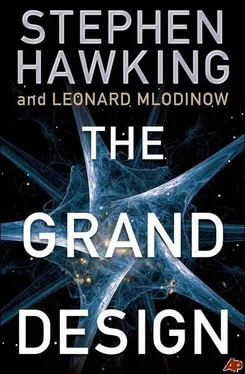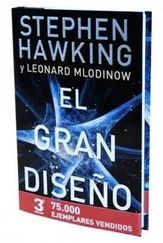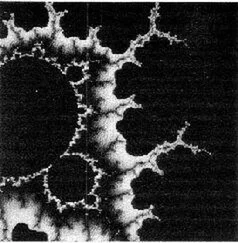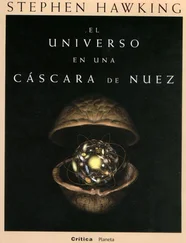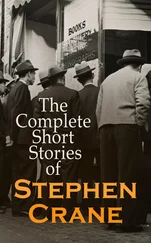According to Newtonian physics-and to the way the experiment would work if we did it with soccer balls instead of molecules-each particle follows a single well-defined route from its source to the screen. There is no room in this picture for a detour in which the particle visits the neighborhood of each slit along the way. According to the quantum model, however, the particle is said to have no definite position during the time it is between the starting point and the endpoint. Feynman realized one does not have to interpret that to mean that particles take no path as they travel between source and screen. It could mean instead that particles take every possible path connecting those points. This, Feynman asserted, is what makes quantum physics different from Newtonian physics. The situation at both slits matters because, rather than following a single definite path, particles take every path, and they take them all simultaneously! That sounds like science fiction, but it isn’t. Feynman formulated a mathematical expression-the Feynman sum over histories-that reflects this idea and reproduces all the laws of quantum physics. In Feynman’s theory the mathematics and physical picture are different from that of the original formulation of quantum physics, but the predictions are the same.
In the double-slit experiment Feynman’s ideas mean the particles take paths that go through only one slit or only the other; paths that thread through the first slit, back out through the second slit, and then through the first again; paths that visit the restaurant that serves that great curried shrimp, and then circle Jupiter a few times before heading home; even paths that go across the universe and back. This, in Feynman’s view, explains how the particle acquires the information about which slits are open-if a slit is open, the particle takes paths through it. When both slits are open, the paths in which the particle travels through one slit can interfere with the paths in which it travels through the other, causing the interference. It might sound nutty, but for the purposes of most fundamental physics done today-and for the purposes of this book-Feynman’s formulation has proved more useful than the original one.
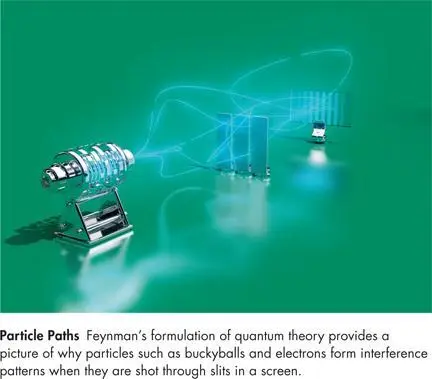
Feynman’s view of quantum reality is crucial in understanding the theories we will soon present, so it is worth taking some time to get a feeling for how it works. Imagine a simple process in which a particle begins at some location A and moves freely. In the Newtonian model that particle will follow a straight line. After a certain precise time passes, we will find the particle at some precise location B along that line. In Feynman’s model a quantum particle samples every path connecting A and B, collecting a number called a phase for each path. That phase represents the position in the cycle of a wave, that is, whether the wave is at a crest or trough or some precise position in between. Feynman’s mathematical prescription for calculating that phase showed that when you add together the waves from all the paths you get the “probability amplitude” that the particle, starting at A, will reach B. The square of that probability amplitude then gives the correct probability that the particle will reach B.
The phase that each individual path contributes to the Feynman sum (and hence to the probability of going from A to B) can be visualized as an arrow that is of fixed length but can point in any direction. To add two phases, you place the arrow representing one phase at the end of the arrow representing the other, to get a new arrow representing the sum. To add more phases, you simply continue the process. Note that when the phases line up, the arrow representing the total can be quite long. But if they point in different directions, they tend to cancel when you add them, leaving you with not much of an arrow at all. The idea is illustrated in the figures below.
To carry out Feynman’s prescription for calculating the probability amplitude that a particle beginning at a location A will end up at a location B, you add the phases, or arrows, associated with every path connecting A and B. There are an infinite number of paths, which makes the mathematics a bit complicated, but it works. Some of the paths are pictured below.
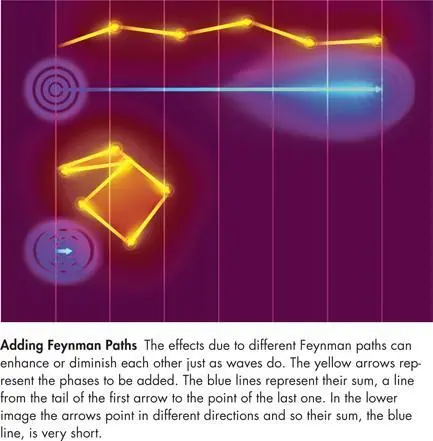
Feynman’s theory gives an especially clear picture of how a Newtonian world picture can arise from quantum physics, which seems very different. According to Feynman’s theory, the phases associated with each path depend upon Planck’s constant. The theory dictates that because Planck’s constant is so small, when you add the contribution from paths that are close to each other the phases normally vary wildly, and so, as in the figure above, they tend to add to zero. But the theory also shows that there are certain paths for which the phases have a tendency to line up, and so those paths are favored; that is, they make a larger contribution to the observed behavior of the particle. It turns out that for large objects, paths very similar to the path predicted by Newton’s will have similar phases and add up to give by far the largest contribution to the sum, and so the only destination that has a probability effectively greater than zero is the destination predicted by Newtonian theory, and that destination has a probability that is very nearly one. Hence large objects move just as Newton’s theory predicts they will.
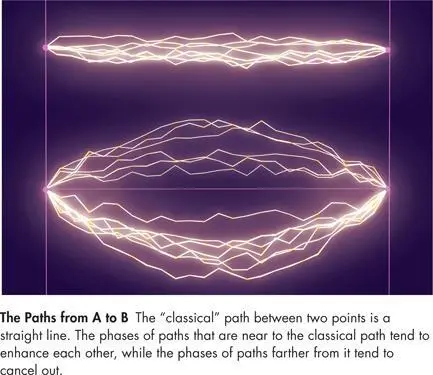
So far we have discussed Feynman’s ideas in the context of the double-slit experiment. In that experiment particles are fired toward a wall with slits, and we measure the location, on a screen placed beyond the wall, at which the particles end up. More generally, instead of just a single particle Feynman’s theory allows us to predict the probable outcomes of a “system,” which could be a particle, a set of particles, or even the entire universe. Between the initial state of the system and our later measurement of its properties, those properties evolve in some way, which physicists call the system’s history. In the double-slit experiment, for example, the history of the particle is simply its path. Just as for the double-slit experiment the chance of observing the particle to land at any given point depends upon all the paths that could have gotten it there, Feynman showed that, for a general system, the probability of any observation is constructed from all the possible histories that could have led to that observation. Because of that his method is called the “sum over histories” or “alternative histories” formulation of quantum physics.
Now that we have a feeling for Feynman’s approach to quantum physics, it is time to examine another key quantum principle that we will use later-the principle that observing a system must alter its course. Can’t we, as we do when our supervisor has a spot of mustard on her chin, discreetly watch but not interfere? No. According to quantum physics, you cannot “just” observe something. That is, quantum physics recognizes that to make an observation, you must interact with the object you are observing. For instance, to see an object in the traditional sense, we shine a light on it. Shining a light on a pumpkin will of course have little effect on it. But shining even a dim light on a tiny quantum particle-that is, shooting photons at it-does have an appreciable effect, and experiments show that it changes the results of an experiment in just the way that quantum physics describes.
Читать дальше
